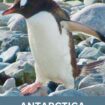
Go World Travel is reader-supported and may earn a commission from purchases made through links in this piece.
Aboard the World Traveller—The churning waters of the perilous Drake Passage have carved fear into the hearts of otherwise brave mariners for centuries. Colossal waves have smashed ships to their timbers and washed sailors overboard.
But after boarding Atlas Ocean Voyages’ new polar-class ship World Traveller, I was terrified of something more daunting than crossing through the “Drake Shake.”
The Polar Plunge
Jumping into the Southern Ocean of Antarctica is a tradition among cruise ships. A silly, stupid, terrifying tradition. But I put it out of my mind as our sleek, dark blue-hulled ship cut through the rough waters.
The crossing lasted the better part of two days from the time we left port in Ushuaia, Argentina. When we finally made our first landfall, at the South Shetland Islands, we were in an otherworldly place that proved to be far more dramatic than I had dreamed.
In the coming days, we would see glaciers, icebergs, razor-tooth mountains, and rocky islets large and small. Minke whales and humpback whales. Gentoo penguins, Adelie penguins, and chinstrap penguins. Albatrosses, petrels, southern fulmars, whale birds, skuas, and Antarctic terns. Fur seals, leopard seals, and crabeater seals. Thanks to the wildlife, our excursions were more on the order of safaris than mere sightseeing.
Our schedules were organized around one or two excursions each day—sometimes on land to see the seals and penguins up close, other times by rubber Zodiac boats in search of birdlife, whales, more seals, and stunning scenery.
But first, we had to get fitted for our warm, waterproof, lime-green parkas and calf-length rubber boots, which we would need to wear on all our day trips.
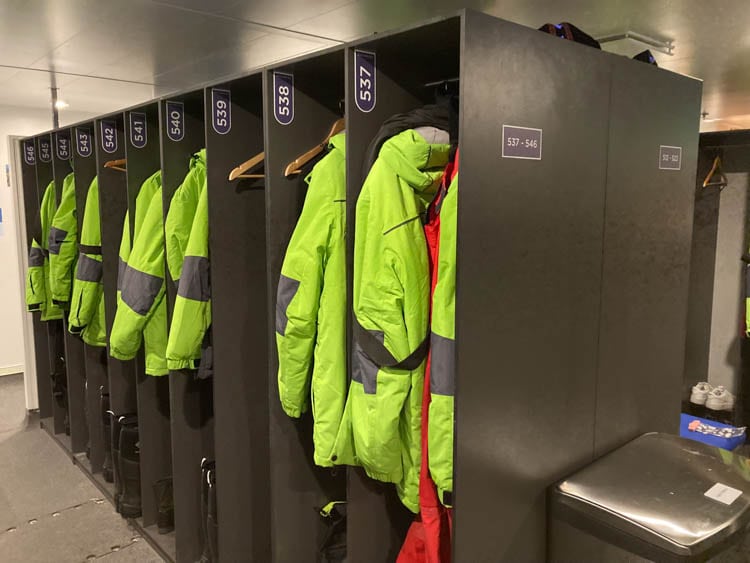
We assembled by groups in the chic Atlas Lounge (our main meeting point throughout the cruise) before going to our pre-assigned lockers in the “mud room” below on Deck 3. Someone recognized the young man calling for specific groups as the talented lounge pianist from the previous evening, Chase Chandler.
“It’s a small ship,” Chandler explained. “We all have to pitch in where we can.”
Down in the mud room, cruise director and entertainer Michael Shapiro was busy helping passengers find the right-size boots and parkas.
“I go from being a mud-room attendant in the morning to singing show tunes at night!” he said with a laugh.
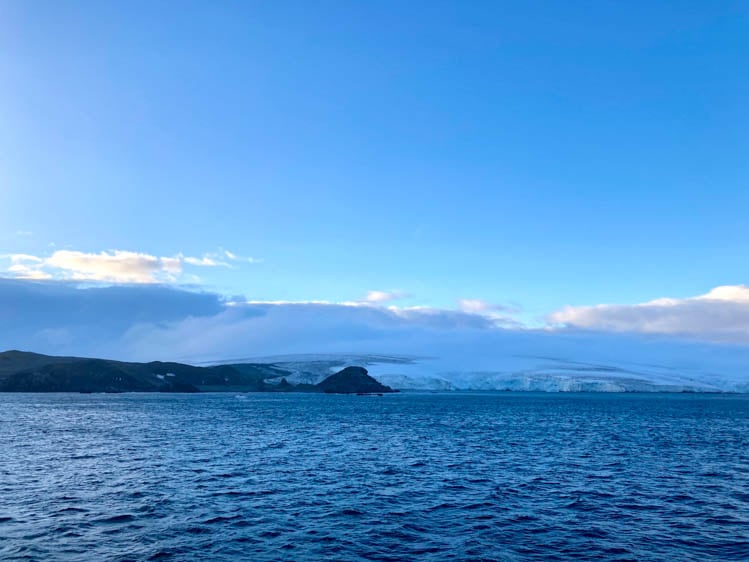
Landfall in the South Shetland Islands
We reached Robert Point in the South Shetland Islands (75 miles north of the Antarctic Peninsula) in the late afternoon of our second full day on the World Traveller.
The schedule called for us to make shore via Zodiacs to view the wildlife. No more than 30 people at a time were allowed on the shingle beach, for environmental reasons.
I was in the mud room donning my boots, parka, and life vest when a 20-minute delay was called. The advance Zodiacs had arrived at the landing site only to find it overrun by fur seals, making it impossible to maintain the recommended 15-foot distance between passengers and animals.
Once the initial Zodiac team found a safe place to land, we were allowed to climb aboard one of the rubber rafts and make our way to Robert Point. The sea was still rough and a fresh breeze was kicking up whitecaps, so we were wet by the time we arrived.
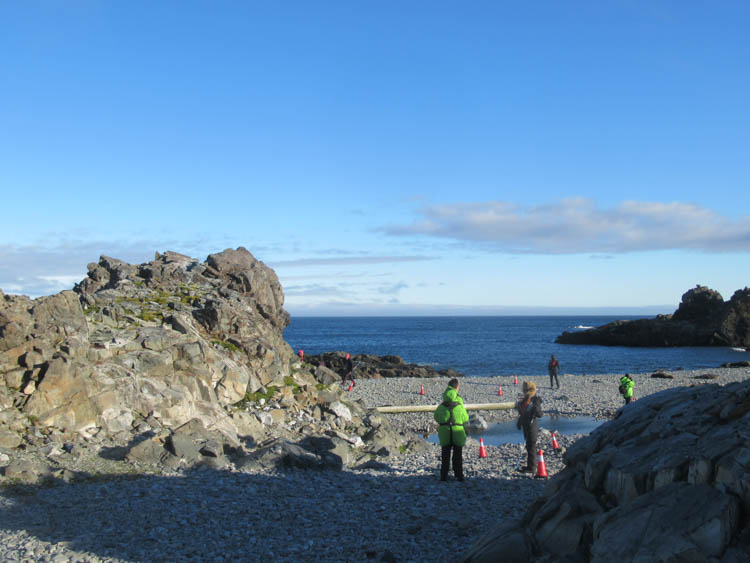
Most of us had some trouble climbing the steep, rock-strewn beach, especially with the awkward rubber boots and the strong wind, but we made it.
Once there, we saw chinstrap penguins all around us. Most of the birds were simply standing and stretching. A few eyed us curiously and waddled in our direction. Fur seals lounging nearby, however, weren’t in the least interested.
Our expedition guides had laid out orange traffic cones to indicate the boundaries within which we could walk (a practice they would follow on all our landings), so as to minimize the ecological impact of our trudging.
Our boots were always scrubbed before and after each surface expedition, but environmental concerns allowed for no sitting or kneeling on land for fear that our clothing might contaminate the ground. The precautions at all our stops were so rigorous that the guides had to speak sternly to passengers who didn’t follow the rules.
READ MORE: 12 Things You Should Know Before Your Cruise to Antarctica
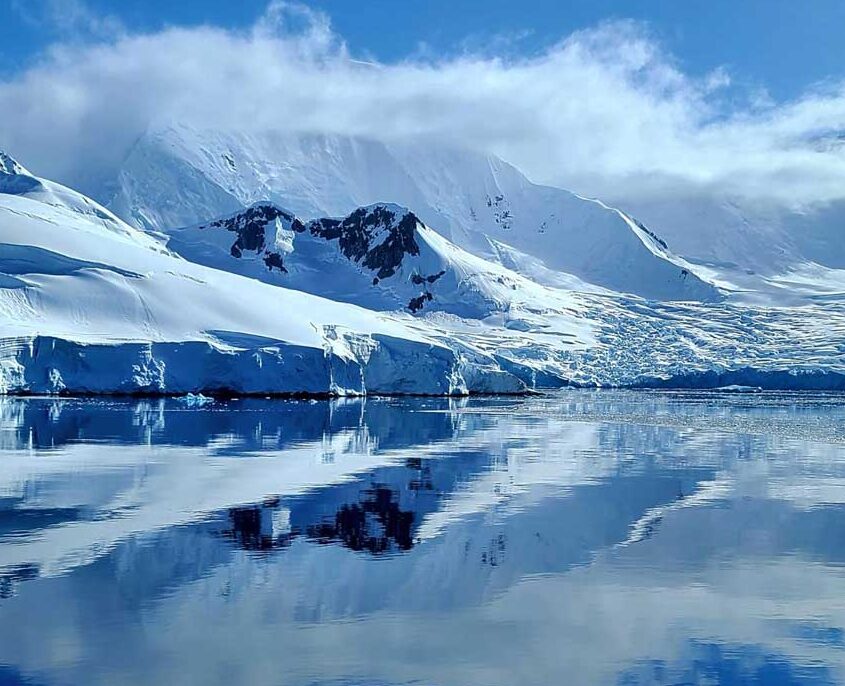
The Antarctic, we quickly learned, is not a glorified zoo.
Nor are the Zodiacs simply pleasure craft. Boarding and getting out of the inflatable boats can be dangerous. When we returned to the World Traveller that day, we had to time the rise and fall of the ocean swells so we wouldn’t try to climb onto the ship’s platform just as the Zodiac suddenly dropped three feet. Fortunately, there were no spills.

Penguins of Cierva Cove and Cuverville Island
One morning early on in our cruise, I woke to find an iceberg outside my stateroom window, the first one I’d seen. We had arrived at Cierva Cove.
We were now well and truly in Antarctica, though not yet on the mainland. My 8 a.m. Zodiac was driven by Sasha Zulas, a meteorologist and veteran Antarctic researcher from Ukraine.
The waterscape was a wonderment. Icebergs bobbed all around us. Beyond were the mighty mountains of Antarctica. One of the peaks was a dead ringer for the Matterhorn.
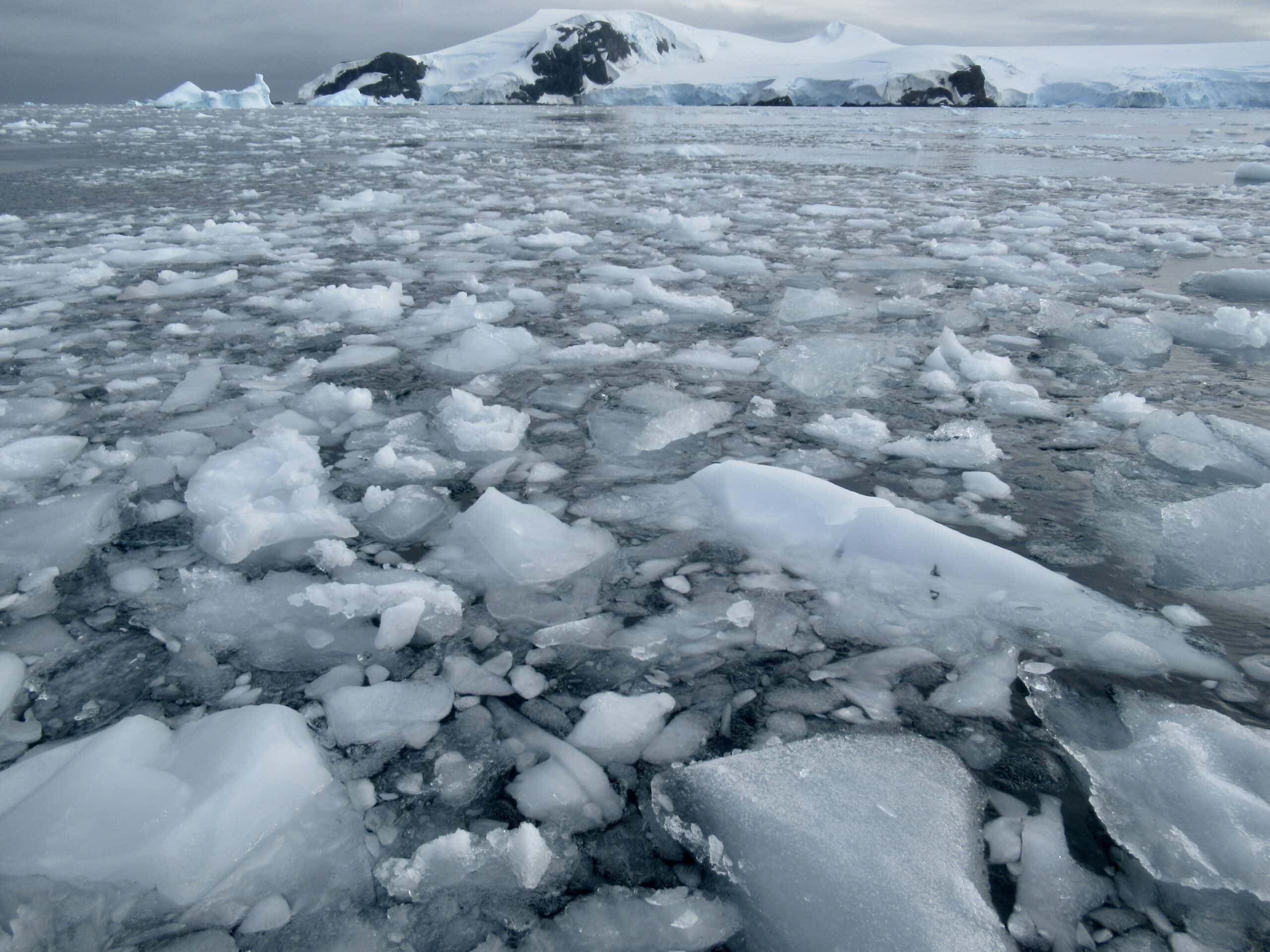
Engulfing a valley, a 100-foot-thick glacier the size of a football field looked ready to slide into the cove and wipe us out with a gigantic wave. Penguins sunned themselves on the rocks and swam alongside us.
Arctic terns zigged and zagged above us like Japanese fighting kites. Our ship, in the far distance, looked tiny and insubstantial in the icy vastness.
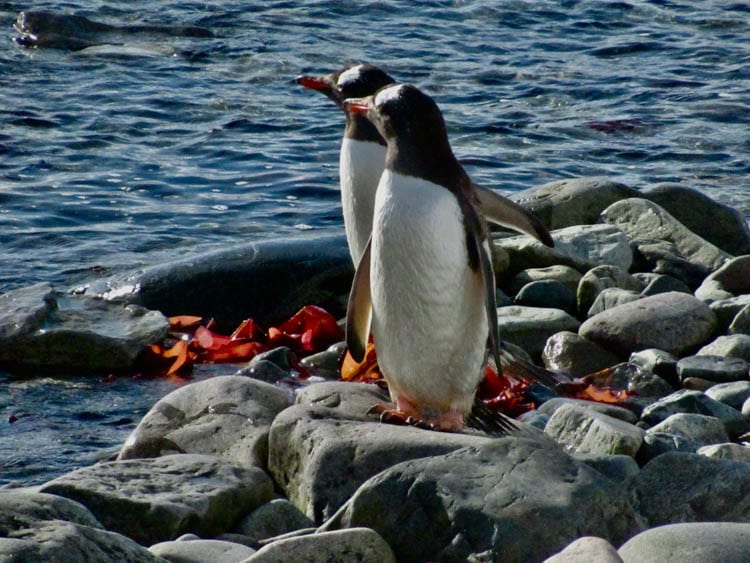
The next day, a sunny Sunday afternoon, we stopped at Cuverville Island, just off the mainland, where we encountered thousands of penguins—the largest colony of Gentoos in Antarctica.
We had to avoid long, narrow depressions in the ice, penguin highways in effect, so as not to damage the birds’ paths between the shoreline and their nesting grounds. Just off the beach, icebergs had been eroded by the wind into otherworldly, surreal shapes.
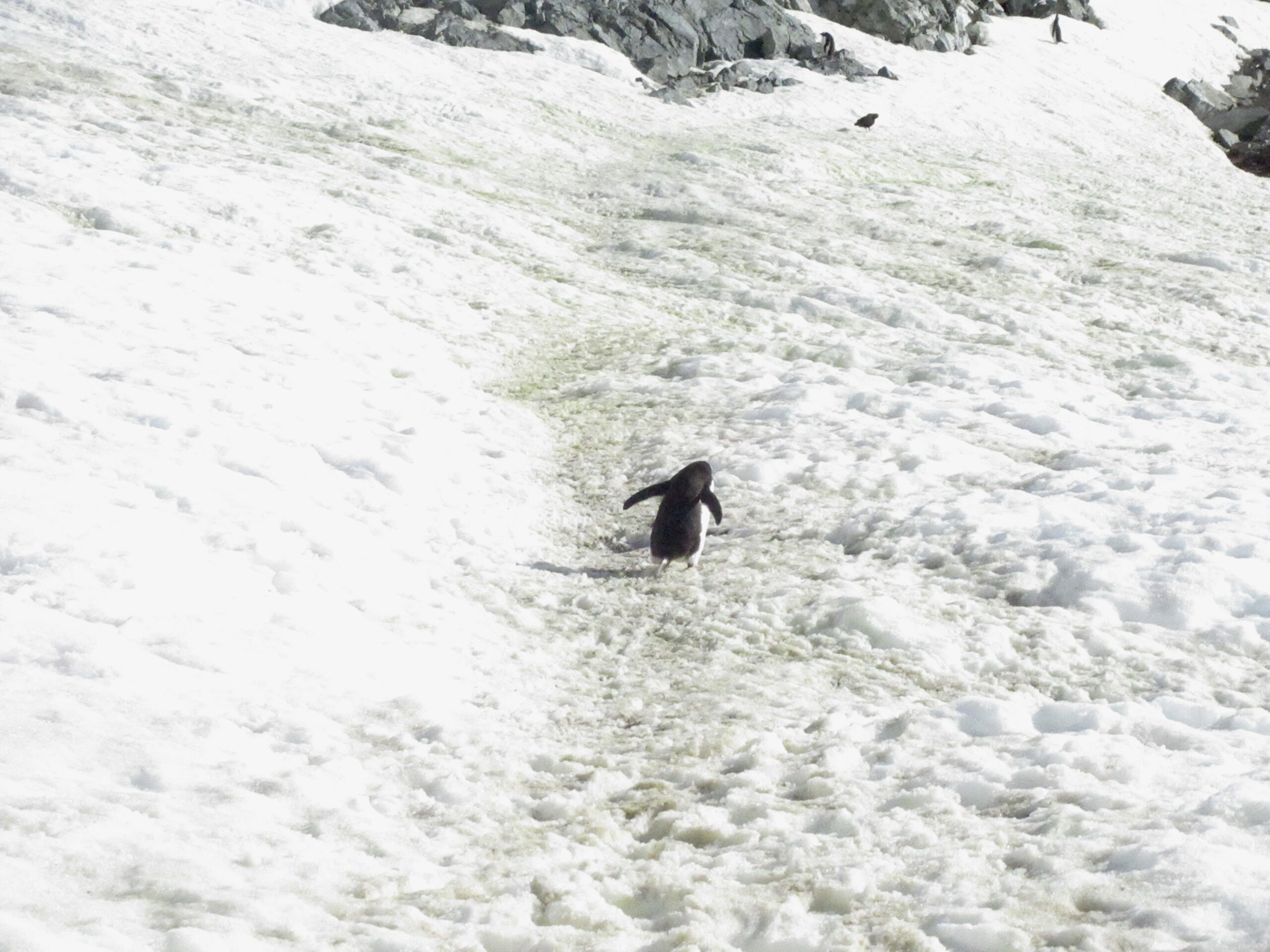
An overnight camping excursion that evening (optional, and for a limited number of travelers) was canceled by a group of Weddell seals that had taken over the campground. The 18 would-be campers were disappointed.
However, the cancelation was a blessing in disguise because our captain, Dimitriy Ashanin, was able to reposition our ship so that the next morning we could visit one of the most glorious settings in Antarctica: Neko Harbor. Not only that, but we would be able to make a continental landing instead of hiking on an offshore island.
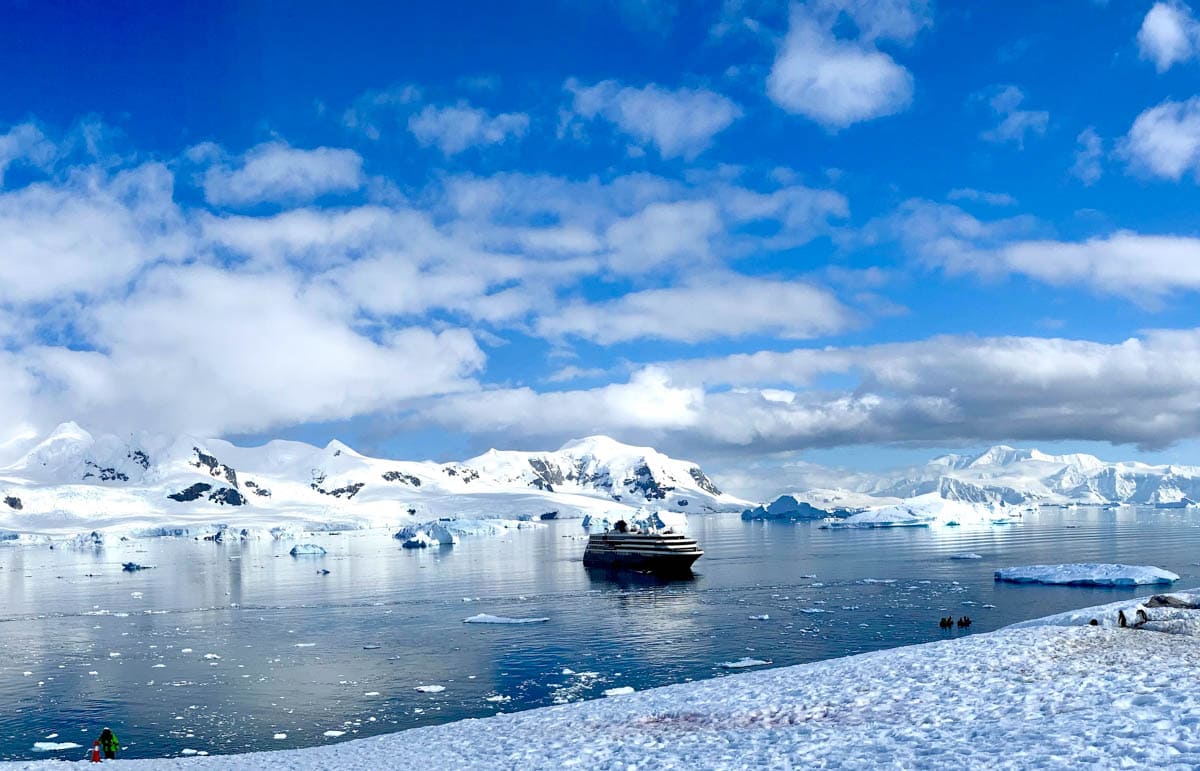
Arriving on the Antarctic Mainland
Climbing out of the Zodiac the next morning and stepping onto shore at Neko, I could now say I had been to the mainland of Antarctica. Rough-hewn rocky peaks surrounded us, icebergs speckled the inlet, and petrels swooped overhead.
Weddell seals basked on boulders under brilliant sunshine. Gentoos squawked and Charlie Chaplin-ed up and down their steep-sloped penguin walkways.
An ear-ringing crack echoed across the inlet as a huge tidewater glacier calved an iceberg into the sea, sending worrisome waves outward.
Another boom followed, this one higher up, and we watched an avalanche fall hundreds of feet before coming to rest (thankfully without any risk to us hikers). A leopard seal nabbed a penguin and ate it in front of a horrified group of cruisers.
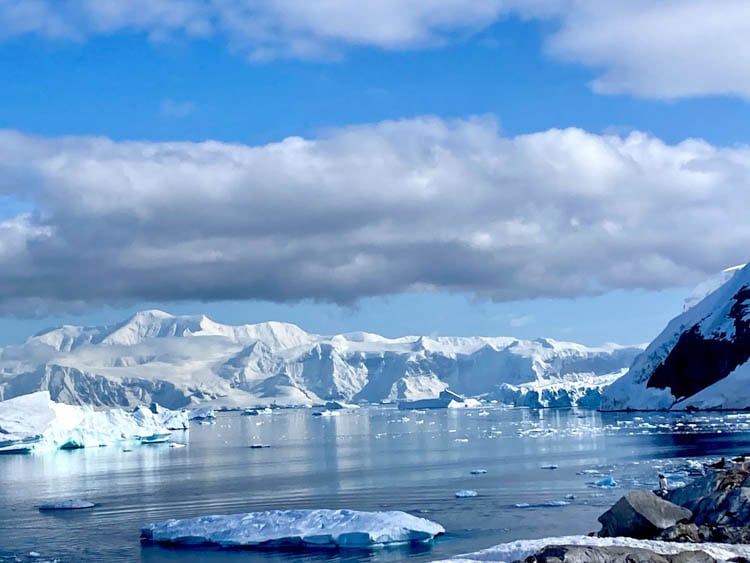
I saw hotel manager Luis Santos after I returned to the ship.
“I can’t imagine there’s any place in Antarctica as magnificent as Neko Harbor,” I said. “You agree?”
Santos smiled as if he knew something I didn’t.
“Just wait until we pass through the Lemaire Channel this evening,” he said, “then let me know if you’ve changed your mind.”
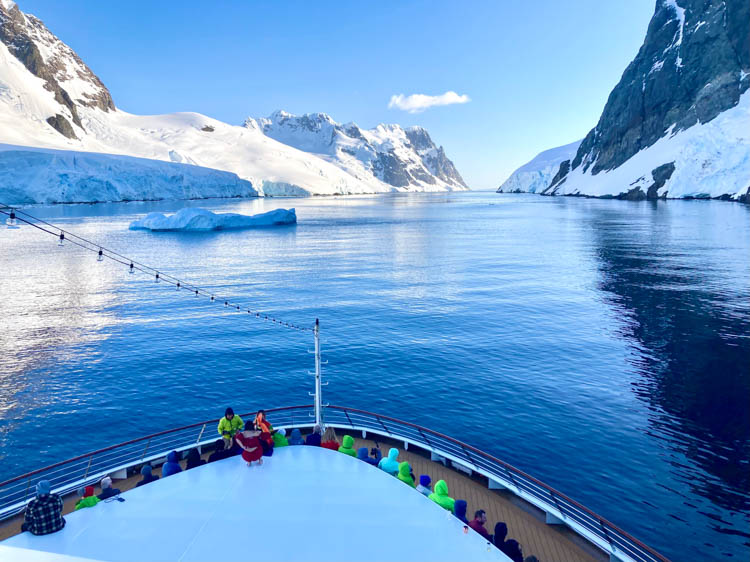
Unforgettable Lemaire Channel
We arrived at Lemaire Channel under an ice-blue sky. Mountains running straight down to the water gave the channel the appearance of a Norwegian fjord. The weather was exquisite, with spectacular sunshine and almost no breeze.
Wind and glacial erosion had sculpted the peaks on either side of us into sharp points. At one section, the channel was so narrow that I could have thrown an Argentine 50-centavo coin to either side and hit land. Then I saw Captain Ashanin arrive on the outdoor observation deck next to me.
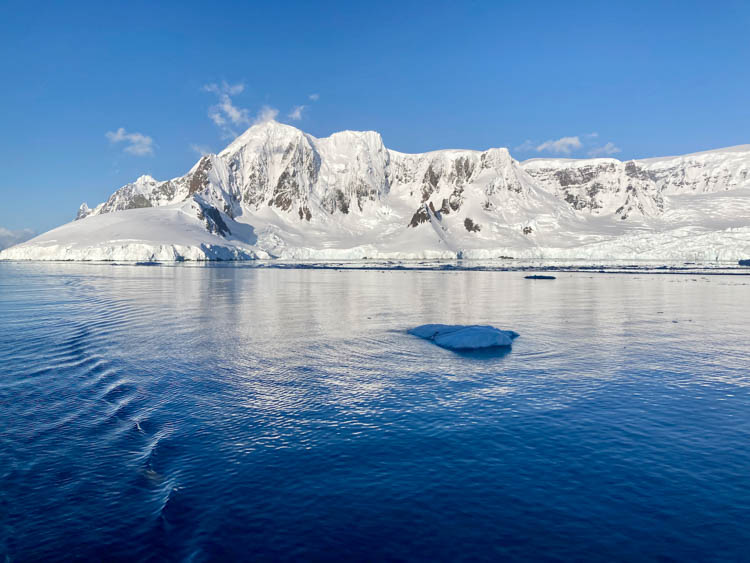
“Captain,” I said in mock alarm, “who’s driving the boat?! Why are you here?”
As he answered, he was furiously snapping pictures with his camera.
“I’ve been coming here since 2014,” he said, almost reverentially. “Never have I seen the channel more beautiful than now. Magnificent!”
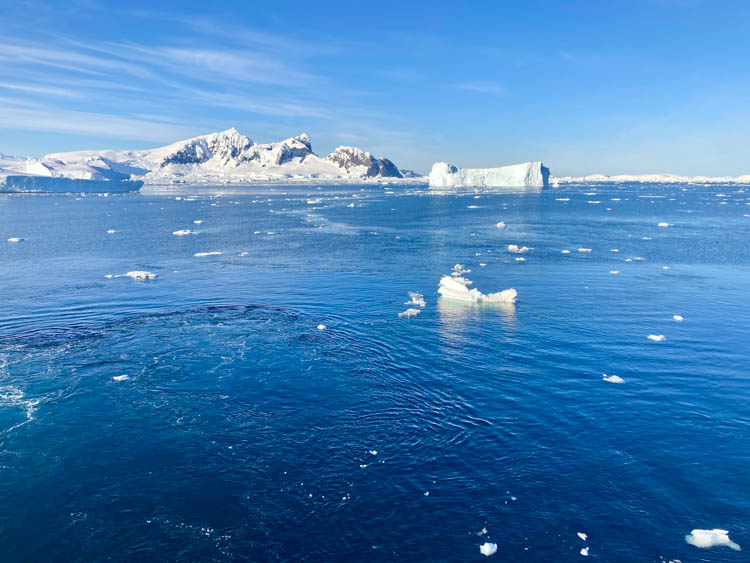
An Eerie, Icy Danger Zone
The next morning, we were supposed to anchor in the Fish Islands, home to thousands of Adelie penguins, which we had yet to see. At 8:30 a.m., just as we prepared for the morning’s excursion, cruise director Michael Shapiro’s voice came over the P.A. system: “Ladies and gentlemen, good morning.”
His tone was not promising. “Because of high winds that are driving ice floes into the channel, we will have to cancel this morning’s activities. It’s too dangerous to be here, so we’ll be leaving. Please remember that your safety is our number one concern.”
I turned to my window to witness an incursion of ice floes and icebergs everywhere. Despite the bright sunshine and blue sky, the growing menace around us was evident. I could see a colony of Adelie penguins some other time. If the captain thinks it’s unsafe, let’s boogie on outta here!
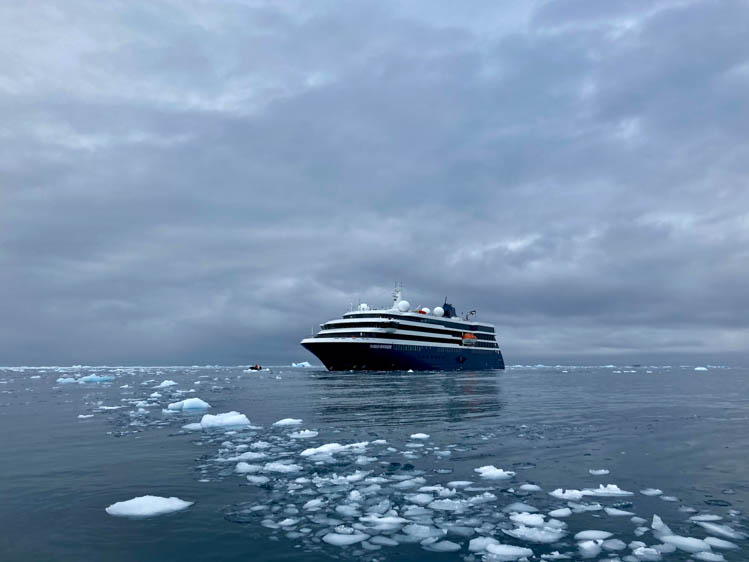
“Antarctica isn’t like just any other place,” said hotel manager Santos. He looked at me meaningfully. “It’s a once-in-a-lifetime experience. But the weather plays a big role in what we can do or can’t. It could be that bad weather closes one of our planned excursions. Or the Drake is getting rougher than usual, and we are forced to return to Ushuaia a day early. Plan A doesn’t always work. The seas can change from calm to five-foot swells in less than an hour. Here, it’s all about the weather, weather, weather.”
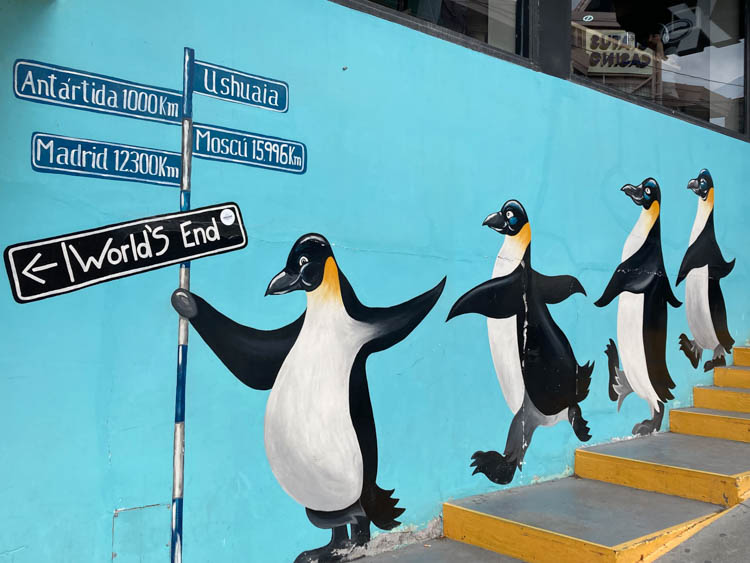
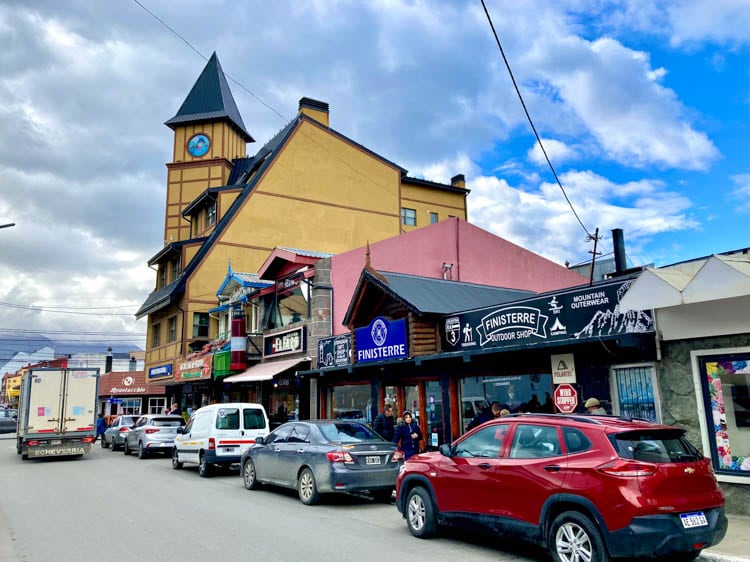
Shortly after fleeing the Fish Islands, though, Shapiro came over the P.A. with good news: “Ladies and gentlemen, this afternoon we’ll be crossing the Arctic Circle, at sixty-six degrees, thirty minutes south latitude.” And then, with an impish lilt to his voice, “We’ll let you know when to expect the bump.”
Remarkable Sights of the Gullet Passage
Our most memorable excursion was a Zodiac tour of the Gullet Passage. Similar to the Lemaire Channel, the Gullet featured towering white mountains on both sides.
Our Zodiac driver-guide was naturalist-historian Jean-Roch de Susanne, a handsome mustachioed Frenchman with a seemingly limitless knowledge of the region.
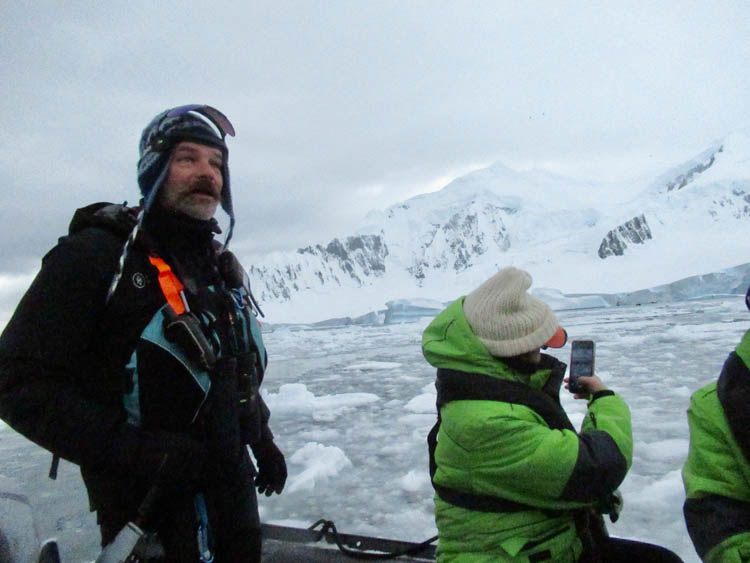
Light snow fell from low gray clouds. In our favor, the weather was windless and a relatively tropical 34 degrees F. Still, I feared that the ice-choked passage might halt our explorations. (The Gullet is ice-free only six weeks a year.)
Our position, as it turned out, marked the southernmost point that the World Traveller had ever reached; it’s doubtful that it will ever go farther south.
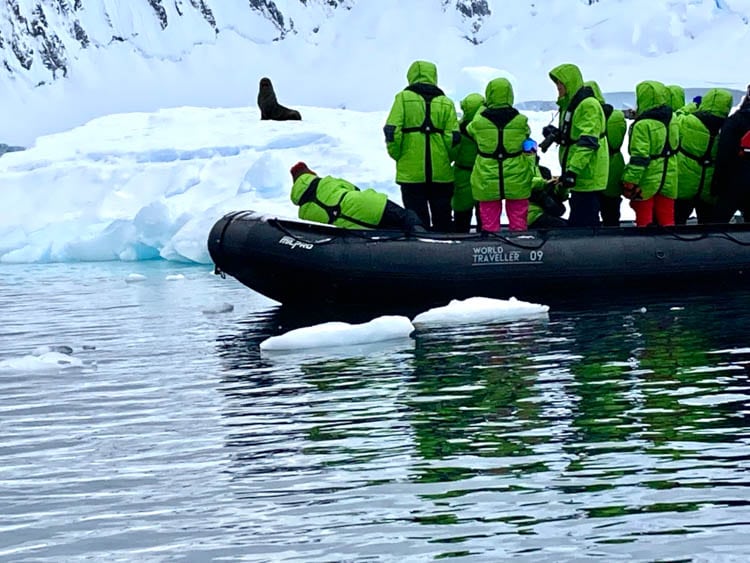
Almost immediately after we set off in the Zodiac, the water came to life. Southern fulmars skimmed inches above the ocean’s surface. Arctic terns, high above, were mere silhouettes against the glaciated mountains.
We floated within shouting distance of a fur seal resting on an ice floe with a crevice that glowed a deep radiant purple instead of the more common neon blue.
A young crabeater seal on another ice floe made as if to slide into the sea, but halfway down had second thoughts and backed up to the top of the floe. Smart seal!
Not far away, three adult crabeater seals lolled on yet another ice floe, stretching out as if getting a suntan under the lowering sky.
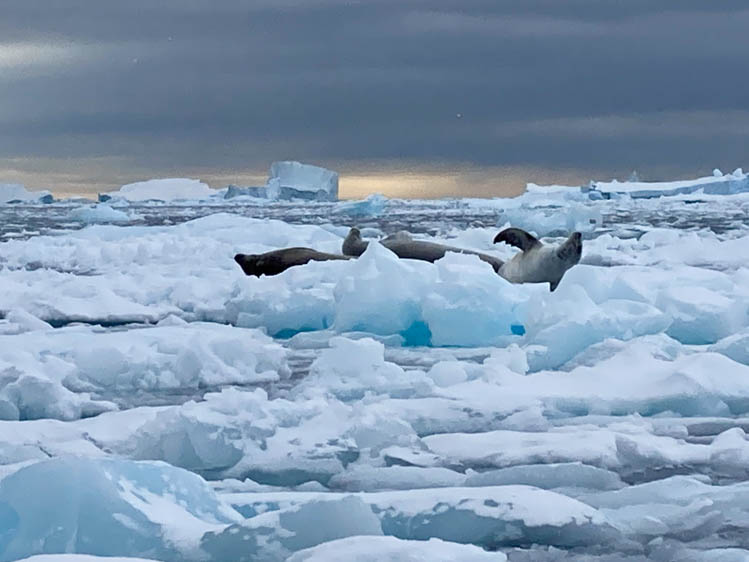
At one point we approached a vast field of floating brush ice, the remnants of a glacier that had spilled off the side of a mountain and broken up into chunks on hitting the water. The ice was so thick here that I worried whether our little rubber boat could pass through it without breaking the propellor, but de Susanne navigated a watery path without incident.
Before returning to the ship, we spotted a female humpback whale and her calf, breaching and diving and waving to us with their flukes before they descended to the depths.
Our excursion had been so successful, and our small group so enthralled by what we had seen, that when we arrived back at the ship we erupted into spontaneous applause and cheers for Jean-Roch, our estimable guide.
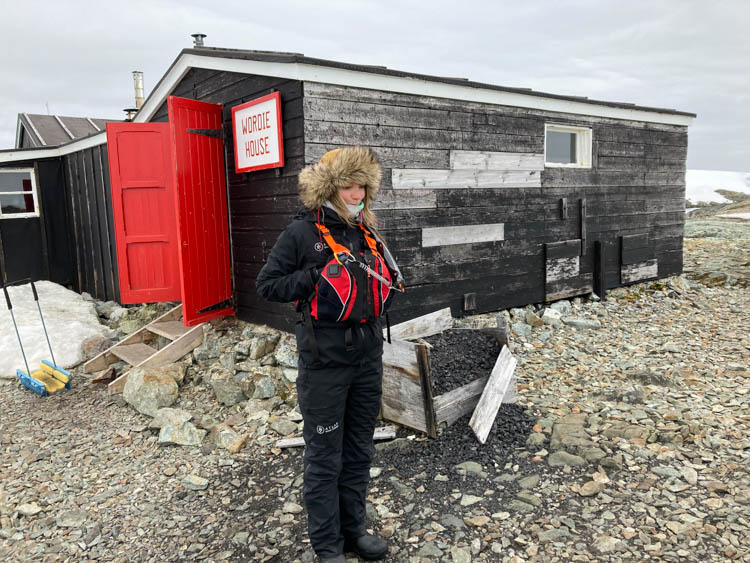
Wordie House, an Unexpected Manmade Relic
The oddest sight on our land expeditions was Wordie House, an abandoned British scientific research station on rocky Winter Island. In use only from 1947 to 1954, the rickety structure was little more than a tarpaper shack at the end of a stone-covered cove. Today it’s a historic monument.
I slowly went inside, afraid to lean against a wall for fear that the entire hut would collapse around my shoulders. The interior looked as if the researchers had just fled the place at a moment’s notice.
Next to a window, a yellow rain slicker and a beat-up guitar hung on a wall. The combination living room/dining room/bedroom held a crazy collection of cast-off, mismatched furniture and bunk beds.
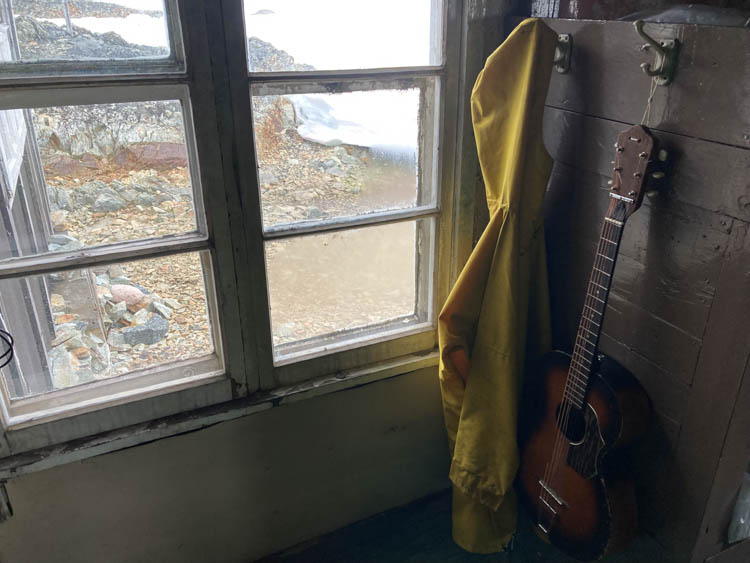
Image by Mark Orwoll
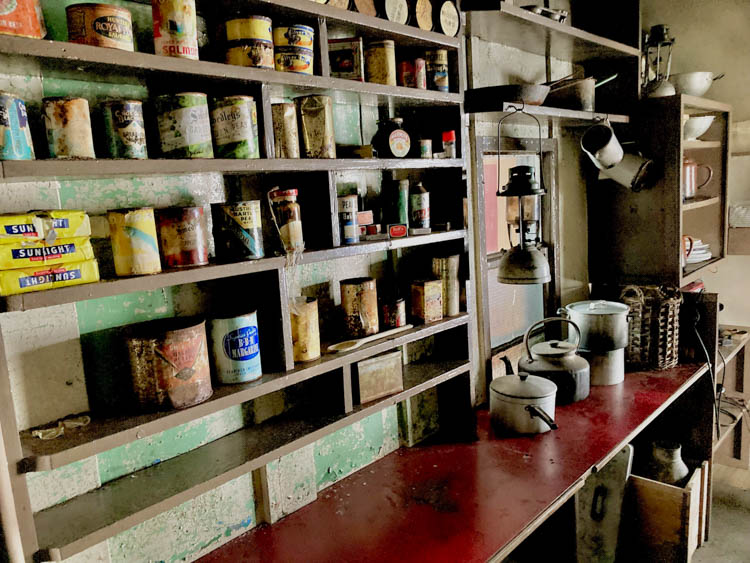
Image by Mark Orwoll
On the kitchen shelves were jars of Marmite, tins of Silver Bell processed cheese and Smedley’s garden peas, boxes of Pearce Duffy’s peach-flavored blancmange, and even a can of McEwan’s Red Label “sparkling” beer from Edinburgh.
Wordie House was heated by a coal-burning stove. In the base commander’s office, a neatly typed report about a supply shipment lay next to an Imperial 66 manual typewriter, illuminated by the weak sun filtering through a dirty window.
Although the station was habitable, I couldn’t imagine spending a weekend there, much less a yearlong stint like the scientists who once lived and worked at Wordie House.
The Luxuries of the World Traveller
During our expedition days, some passengers occasionally decided to forgo an excursion and instead enjoy the pleasures of the ship itself. The 198-passenger World Traveller debuted in late November 2022, and still had that new-car smell.
I liked the way it looked. The design theme in the public spaces was distinctly and appropriately nautical. Antique photos of sailing ships and ocean liners decorated the stairwells. The carpet patterns throughout also recalled a sailing heritage, with designs resembling naval pennants and masthead flags.
The Deck 7 Dome Observation Lounge, with its glass roof and 1940s-style bar, was the favored hang-out for most of the passengers. The lounge’s walls were lined with handsome, shining wood paneling. Wall sconces with lampshades lent a touch of elegance.
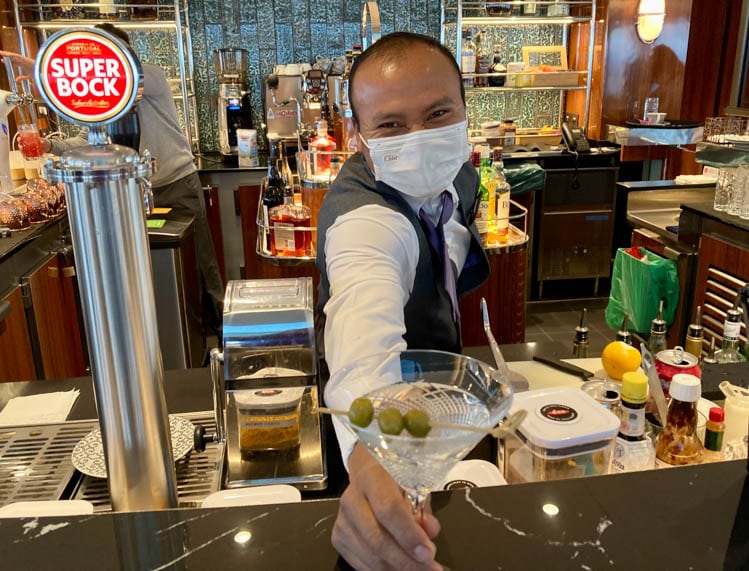
Deck 4, where most of the daytime activities occurred, was also home to Lisboa (the ship’s main restaurant, with open seating), the reception desk, the excursion center, Paula’s Pantry coffee bar (for early risers’ java fix and between-meal snacks), a fitness room, the quiet Atlas Lounge, and the Vasco da Gama Auditorium, an intimate space where the naturalists gave lectures and daily briefings and where movies were screened.
A small spa (with sauna), the SeaSpa by L’Occitane, proffered massages and facials. A few hardy guests braved the cold breezes to swim in the 77-degree heated open-air pool or soak in the 98-degree Jacuzzi.
The staterooms were as elegant as the rest of the ship’s interiors, with large bathrooms (the showers had rain shower heads and side jets), adequate closet space, beds that could be set up as singles or queens, and either balconies or large picture windows that could be partly raised and lowered to allow fresh air inside.
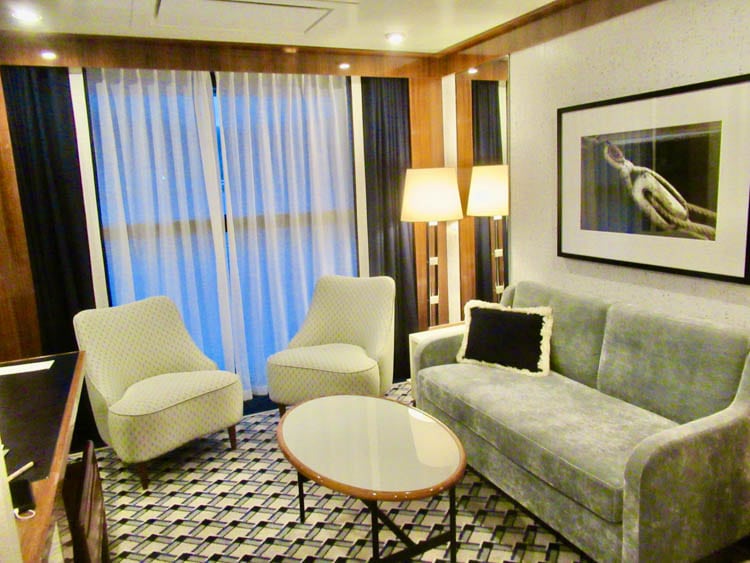
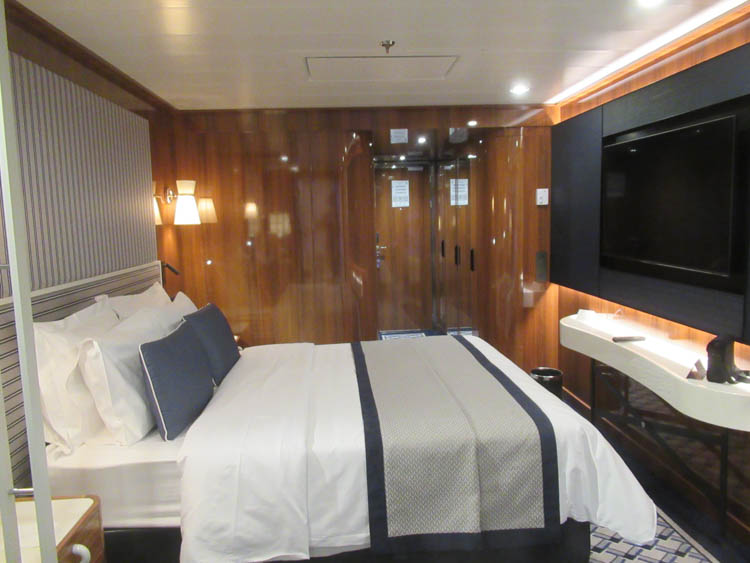
Lisboa, the ship’s main restaurant, served a buffet breakfast and lunch. Morning choices were abundant but cruise-ship standard: scrambled eggs, bacon, sausage, baked beans, cold meats and cheeses, bread and pastries, a variety of juices, and tea and coffee.
Guests could also order a la menu for fresh omelets, waffles, and daily specialties like Mexican baked eggs with chili and Austrian pancakes with apricot jam and vanilla sugar. At noon, Lisboa featured a carving station, hot vegetable dishes, soups, and a salad bar.
The seated dinner always offered standards every night (sirloin steak, salmon, chicken, pasta) and a special international menu that changed from day to day: Arabic, Peruvian, Chilean, Portuguese, Brazilian, and more.
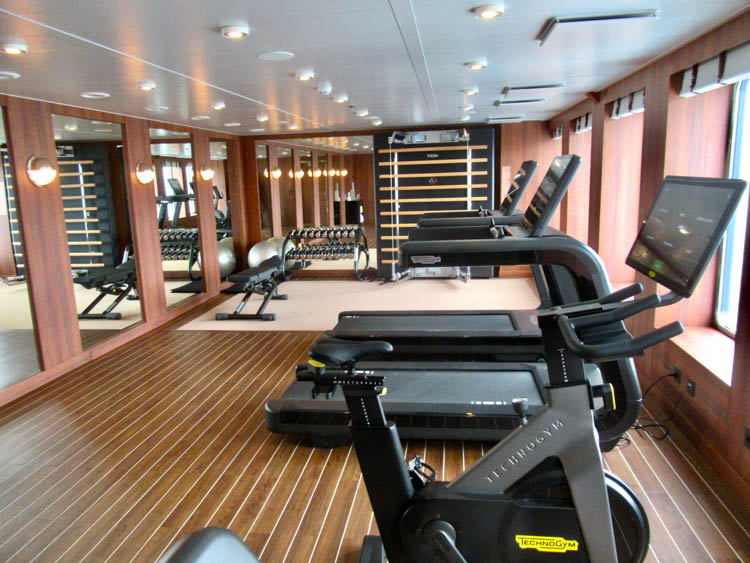
The quality of cuisine was high, especially considering the limitations a chef must contend with on an Antarctic itinerary. The World Traveller can’t pick up additional supplies once it leaves Ushuaia. And even in that city, the ship’s home port for the four-month season, the wealth of ingredients needed to feed some 200 passengers on a 10- or 12-day cruise can’t be found.
The cruise line freights in almost all its food from Europe, so many of the ingredients arrive frozen. There was no consensus about the food among the passengers I spoke with; their comments ranged from meh to magnificent.
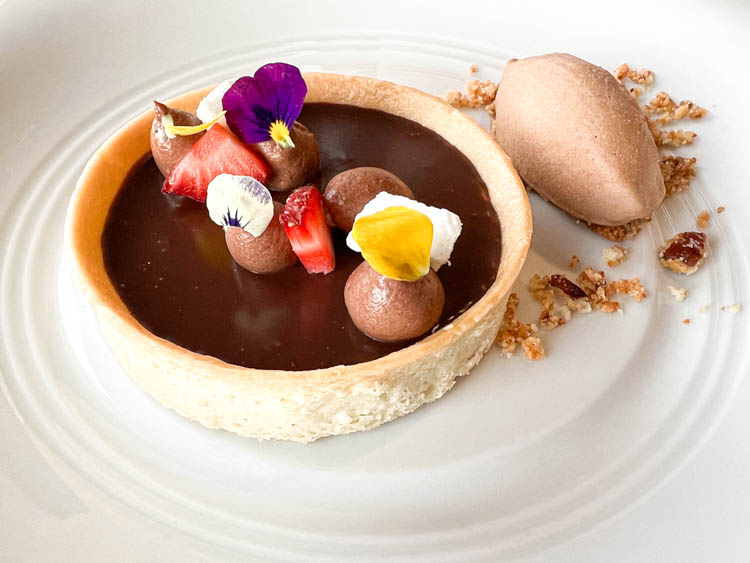
“What do they want?” one woman said to me. “We’re at the bottom of the world, nowhere near civilization, eating delicious Italian and Arabic and Portuguese meals!”
The entertainment on board was limited but well-suited to the setting. The personable cruise director, Michael Shapiro, had a long history as an actor and singer. His musical-theater background was in full feather the evening of our third day out and again a few nights later.
Ably accompanied by pianist Chase Chandler in the Dome Observation Lounge, Shapiro belted out songs from the Great American Songbook for over an hour, putting incredible energy into each number.
Additionally, on nights when Shapiro wasn’t entertaining the passengers, an intriguing, destination-appropriate movie would play in the Vasco da Gama Auditorium (Cape Horn with Irving Johnson, Shackleton’s Antarctic Adventure).
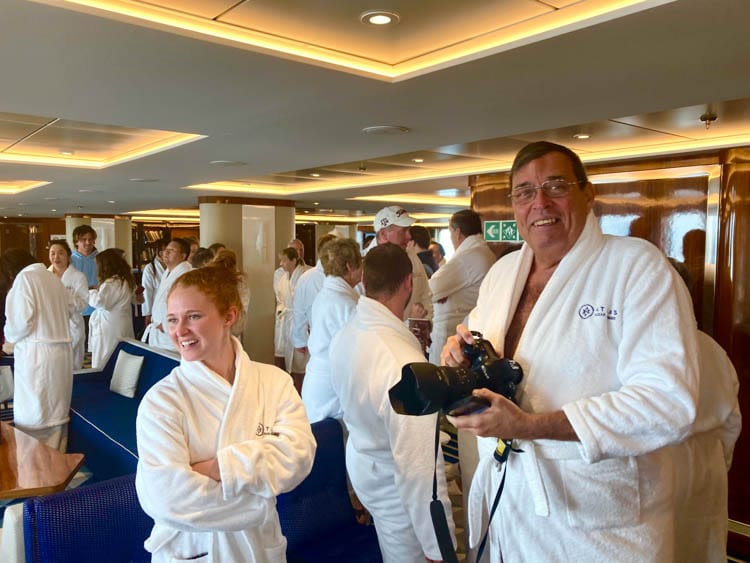
The ((Gulp!)) Polar Plunge
Of course, the most entertaining event of all was the Polar Plunge, which was finally scheduled on a sunny, calm afternoon at 67 degrees latitude, well inside the Antarctic Circle.
I was still iffy about jumping in. The morning before, I had turned on the side jets while I was under the rain shower head in my bathroom. Ice water unexpectedly shot out of the jets at first spurt. I squealed like a little girl.
Participating passengers were requested to come to the Atlas Lounge in bathing suits and bathrobes, then go in groups to the mud room on Deck 3. Although I too was in my bathing suit and robe, I figured I could ease myself out of line and scurry back to my stateroom unnoticed.
Nonparticipating guests jockeyed for window space on the upper decks to watch the ridiculous goings-on.
“What are you guys doing?!” I said in exasperation to a group of voyeurs. “You like to see people suffer? I’ll bet in a previous life you were cheering Nero whenever he turned a thumbs-down at the Colosseum.”
Downstairs, I joined the waiting jumpers. The next passenger leaped into the water, made a splash, and emerged with an expression of stark terror and physical pain. In a moment of clarity and self-understanding, I realized that I’m more of a hot-tub guy.
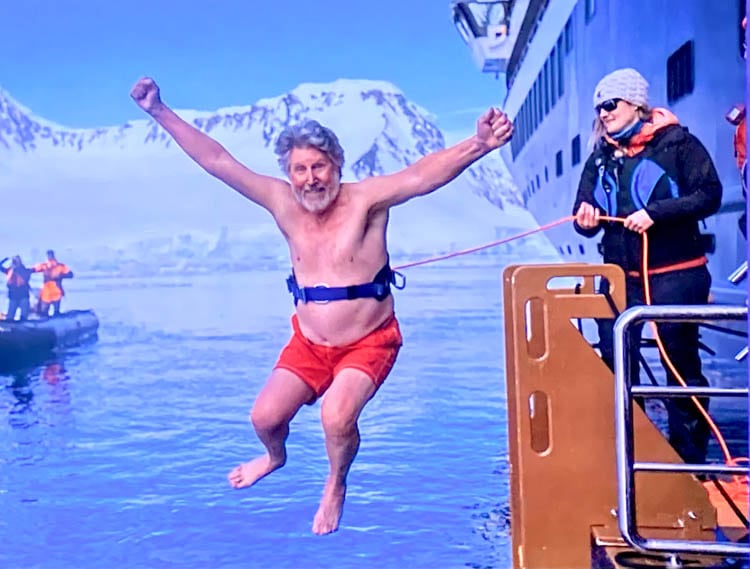
My wife’s last words to me before I departed a week earlier came back to me: “Whatever happens, do NOT do the Polar Plunge. You’ll have a heart attack and die!”
Marital harmony is far more important than a self-indulgent dip in the Antarctic’s Southern Ocean. Still, I stood in line with the other knuckleheads, pretending I would jump. Somehow, I eventually found myself at the head of the line. The 31.5-degree F. seawater gurgled at my feet.
Kathy’s words came back to haunt me again: “You’ll have a heart attack and die!” That’s when I decided to be sensible, step out of line, and go back to my warm and cozy stateroom. Instead, I closed my eyes and squealed like a little girl.
And then I jumped.
Atlas Ocean Voyages’ World Traveller sails in Antarctica from November through March, in Europe from April through October, and in the Arctic and Iceland in August.
READ MORE: 12 Things You Should Know Before Your Cruise to Antarctica
- You’re Pronouncing it Wrong: Why the Caribbean’s Best Kept Secret Isn’t What You Think - June 6, 2025
- The Gentle Art of Doing Nothing Isn’t Easy in Providenciales,Turks and Caicos - January 21, 2025
- Seeing the Canary Islands Under Full Sail - May 10, 2024

